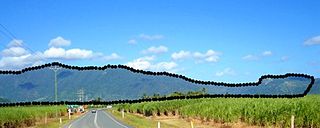Related Research Articles

Australian Aboriginal religion and mythology is the sacred spirituality represented in the stories performed by Aboriginal Australians within each of the language groups across Australia in their ceremonies. Aboriginal spirituality includes the Dreamtime, songlines, and Aboriginal oral literature.
Baralku, also written Burralku or Bralgu, is a place connected with creation ancestors in the mythology of the Yolngu people of Arnhem Land in the Northern Territory of Australia. It is referred to as island of the dead, and the place where the ancestors known as Djanggawul (Djan'kawu) originated, before travelling by canoe to Yalangbara, where they gave birth to the Rirratjingu clan.
The Wawalag sisters also known as the Wauwaluk, Wawilak or Waggilak, or Wawalik sisters are ancestral beings whose story is part of ‘the most widespread’ sacred rituals in the aboriginal culture from Arnhem land, Northern Territory, Australia. Their story takes place in dreamtime, a period of time in aboriginal belief where ancestral beings created the land as well as the social and linguistic structures in it. The sisters are said to have helped draw linguistic and social differences amongst the clans in Arnhem land, but the ceremonies associated with their stories create cultural unity.

The Yolngu or Yolŋu are an aggregation of Aboriginal Australian people inhabiting north-eastern Arnhem Land in the Northern Territory of Australia. Yolngu means "person" in the Yolŋu languages. The terms Murngin, Wulamba, Yalnumata, Murrgin and Yulangor were formerly used by some anthropologists for the Yolngu.
A songline, also called dreaming track, is one of the paths across the land within the animist belief system of The First Nations People of Australia, which mark the route followed by localised "creator-beings" during the Dreaming. The paths of the songlines are recorded in traditional song cycles, stories, dance, and art, and are often the basis of ceremonies. They are a vital part of Aboriginal culture, connecting people to their land.
Ronald Murray Berndt was an Australian social anthropologist who, in 1963, became the inaugural professor of anthropology at the University of Western Australia.

Barnumbirr, also known as Banumbirr or Morning Star, is a creator-spirit in the Yolngu culture of Arnhem Land in Australia, who is identified as the planet Venus. In Yolngu mythology, she is believed to have guided the first humans, the Djanggawul sisters, to Australia. After the Djanggawul sisters arrived safely near Yirrkala in North East Arnhem Land, Barnumbirr flew across the land from East to West, creating a song-line which named and created the animals, plants, and geographical features.
Baijini are a race of people, mythical or historical, mentioned in the Djanggawul song cycle of the Yolngu people, an Aboriginal Australian people of Arnhem Land in the Northern Territory.
The Bininj are an Aboriginal Australian people of Western Arnhem land in the Northern Territory. The sub-groups of Bininj are sometimes referred to by the various language dialects spoken in the region, that is, the group of dialects known as Bininj Gun-Wok; so the people may be named Gunwinggu, the Kuninjku, Kundjeyhmi (Gundjeihmi), Manyallaluk Mayali, Kundedjnjenghmi and Kune groups. In addition, there are clan groups such as the Mirrar who are prominent in matters relating to looking after the traditional lands.
The Nunggubuyu are an Aboriginal Australian people of eastern Arnhem Land in the Northern Territory.
The Yan-nhaŋu, also known as the Nango, are an indigenous Australian people of the Northern Territory. They have strong sociocultural connections with their neighbours, the Burarra, on the Australian mainland.
The Dangu are an Aboriginal Australian people of Arnhem Land, in the Northern Territory, one of many Yolŋu peoples. They are, according to Norman Tindale, to be carefully distinguished from the Djaŋu.
The Dalabon or Dangbon are an Australian Aboriginal people of the Northern Territory.
The Gungorogone are an indigenous Australian people of the Northern Territory.
Banduk Mamburra Marika was an artist and printmaker from Arnhem Land, Northern Territory, Australia. She was a member of the Rirratjingu clan of the Yolngu people, whose traditional land is Yalangbara. She was also an environmental activist and leader.
Wonggu Mununggurr (c.1880–1959) was an Aboriginal Australian artist and leader of the Djapu clan of the Yolngu people of northeast Arnhem Land in the Northern Territory of Australia.
Mickey Durrng Garrawurra (1940–2006), usually referred to as Mickey Durrng, was an Aboriginal Australian artist known for his natural ochres and pigments on paper, bark, and logs.
Mungurrawuy Yunupingu (c.1905–1979) was an Aboriginal Australian artist and leader of the Gumatj clan of the Yolngu people of northeastern Arnhem Land in the Northern Territory of Australia.
Mawalan Marika (c.1908-1967) was an Aboriginal Australian artist and the leader of the Rirratjingu clan of north-east Arnhem Land, Northern Australia. He is known for his bark paintings, carvings and political activism.
Yalangbara is a coastal area in the East Arnhem region of Australia's Northern Territory. It is on the country of the Rirratjingu clan of the Yolŋu people. The area is around 35 kilometres south of Nhulunbuy, the largest town in the area. In Yolŋu terminology, Yalangbara is a yaku bathala, a term for a general area that comprises various smaller named localities.
References
- 1 2 West, Margie (7 December 2010). "Yalangbara: art of the Djang'kawu". Western Australian Museum . Retrieved 17 July 2021.
- ↑ Wells, A.E. (1971). This their dreaming. UQ Press, St.Lucia,Qld.
- ↑ Berndt, Ronald M. (2004). Djanggawul: An Aboriginal Religious Cult of North-Eastern Arnhem Land. Routledge. p. 1. ISBN 978-0-415-33022-0. (Originally published 1952)
- ↑ Oliver, Douglas L. (1989). Oceania: The Native Cultures of Australia and the Pacific Islands. University of Hawaii Press, Honolulu.
